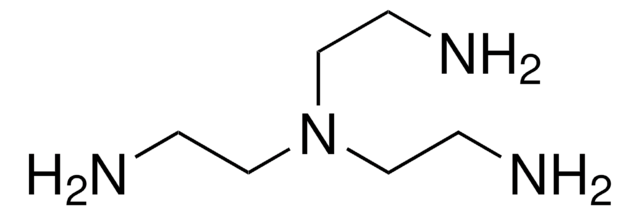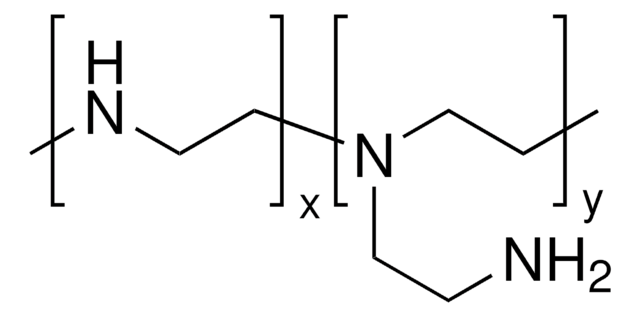408719
Polyethylenimine, ethylenediamine end-capped
average Mw ~800 by LS, average Mn ~600 by GPC
Synonyme(s) :
PEI, ethylenediamine branched
About This Item
Produits recommandés
Forme
viscous liquid
Poids mol.
average Mn ~600 by GPC
average Mw ~800 by LS
Indice de réfraction
n20/D 1.5240
Densité
1.050 g/mL at 25 °C
Chaîne SMILES
N1CC1.NCCN
InChI
1S/C2H8N2.C2H5N/c3-1-2-4;1-2-3-1/h1-4H2;3H,1-2H2
Clé InChI
SFLOAOINZSFFAE-UHFFFAOYSA-N
Catégories apparentées
Description générale
Application
Bamboo charcoal impregnated with PEI can be used as a CO2 adsorbent. Numerous amino groups present in PEI can react with CO2 due to acid-alkali interaction and enhance the adsorption capacity of bamboo charcoal.
It can also be used to prepare cross-linked water-soluble polymers with high coordination capabilities towards organic drug molecules.
Caractéristiques et avantages
- Branched PEI has better complexation and buffering capacity.
- High ion exchange capacity and affinity toward proteins.
- SignificantDNA transfer efficiency.
Forme physique
Mention d'avertissement
Danger
Mentions de danger
Conseils de prudence
Classification des risques
Acute Tox. 4 Oral - Aquatic Chronic 2 - Eye Dam. 1
Code de la classe de stockage
10 - Combustible liquids
Classe de danger pour l'eau (WGK)
WGK 3
Point d'éclair (°F)
356.0 °F
Point d'éclair (°C)
180 °C
Équipement de protection individuelle
Eyeshields, Faceshields, Gloves, type ABEK (EN14387) respirator filter
Faites votre choix parmi les versions les plus récentes :
Déjà en possession de ce produit ?
Retrouvez la documentation relative aux produits que vous avez récemment achetés dans la Bibliothèque de documents.
Les clients ont également consulté
Articles
Professor Yoshiki Katayama (Kyushu University, Japan) discusses recent advances in drug delivery systems and strategies that exploit the EPR effect, with a special focus on stimuli-responsive systems based on novel materials.
Gene therapy has become one of the most discussed techniques in biomedical research in recent years.
The CRISPR/Cas9 system has recently emerged as a highly specific, efficient, and versatile gene editing technology that can be utilized to build disease models and correct diseased genes. Safe and effective delivery vectors for the CRISPR/Cas9 system are in critical need to enable clinical development and future applications of CRISPR/Cas9 systems. Professor Yang Liu summarizes recent progress in nonviral nanoparticle approaches for CRISPR/Cas9 delivery.
We present an article that discusses two applications in particular; first, using these layers as polyelectrolyte membranes to control permeability.
Notre équipe de scientifiques dispose d'une expérience dans tous les secteurs de la recherche, notamment en sciences de la vie, science des matériaux, synthèse chimique, chromatographie, analyse et dans de nombreux autres domaines..
Contacter notre Service technique










